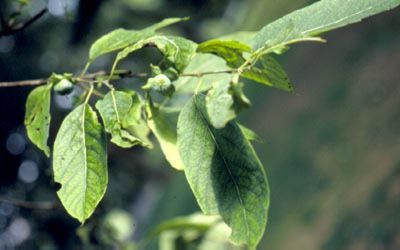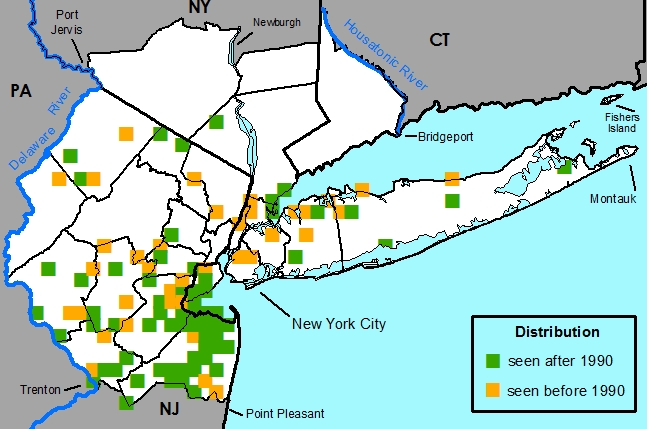Diospyros virginiana L. - Common Persimmon

Photo © by Steven Clemants
Taken at the Brooklyn Botanic Garden, NY, 1999.
Native , Frequent
By Angela Steward & Steven D. Glenn
Not peer reviewed
Last Modified 02/01/2013

Common Names
Common PersimmonField Identification
Deciduous tree up to 15 m high. Bark deeply furrowed into small blocky plates cross-checked with orange. Leaves alternate, simple, elliptic to ovate, margins entire. Fruits rounded, 1-1.5 inches in diameter, yellowish to orange to red.Food uses
Disclaimer: The information provided here is for reference and historical use. We do not recommend nor do we condone the use of this species for food purposes without first consulting a physician.(Foster and Duke, 1990) (Plants For a Future Database, 2003) (Spongberb, 1991) (Moerman, 1998)
Used by Native Americans as well as Euopean settlers, ripe persimmon fruits are rich in flavor and used cooked and dried in breads, cakes, pies, preserves, and puddings. Molasses can be made from the pulp of ripe fruits. Oils, tasting of peanut oil, can be obtained by crushing the seeds. Tea can be made from dried persimmon leaves and a coffee substitute from its roasted seeds. Also can be utilized to make brandy, wine, and persimmon beer, which Thomas Jefferson enjoyed. Fruits for consumption are best harvested in autumn after a heavy frost to ensure they are properly ripened. Unripe fruits are very astringent and essentially inedible.
Many cultivars have been selected for exceptional fruiting, see Goodell, 1982.
Medicinal uses
Disclaimer: The information provided here is for reference and historical use. We do not recommend nor do we condone the use of this species for medicinal purposes without first consulting a physician.(Foster and Duke, 1990) (Moerman, 1998)
The inner bark of the American Persimmon has astringent qualities. Used by Native Americans as well as Euopean settlers, it has been used to treat sore throats, stomache aches, heartburn, diarrhea, and dysentery.
Other uses
In the past, the wood of American Persimmon was used to make golf club heads and weaver shuttles. This practice has largely been discontinued due to a reliance on laminates and other synthetic materials. (Alabama Forest Comission, 2003)It is a valuable honey plant. (Schopmeyer, 1975)
Stories
Poisonous properties
Disclaimer: The information provided here is for reference and historical use. If you believe you have been poisoned, please contact the Poison Control Office near you (look for the number in the front of the phone book).
(Foster and Duke, 1990) (Burrows, 2001)
Contains tannins that are toxic in large amounts. Most cases of poisoning occur in horses and cattle, escpecially when immature fruits are consumed in large quantities. Digestive dysfunction is the main symptom. Poisoning in humans is rare.
Nomenclature
*Diospyros virginiana L., Sp. Pl. 1057. 1753.Diospyros guajacana Romans, Nat. Hist. Florida, 20. 1775.
Diospyros concolor Moench, Meth. Pl. 470. 1794.
Diospyros virginiana var. concolor Raf., Med. Fl. 155. 1828.
Diospyros virginiana var. macrocarpa et var. microcarpa Raf., Med. Fl. 155. 1828.
Diospyros persimon Duden, Ber. Reise Westl. Staat. Nordam. 58. 1829 "diospiros".
Diospyros ciliata Raf., New Fl. N. Am. 3: 25. 1837.
Diospyros lucida Hort. ex Dippel, Handb. Laubh. 1: 306. 1889.
Diospyros distyla Hort. ex Dippel, Handb. Laubh. 1: 306. 1889.
Persimon virginiana Raf. ex B. D. Jackson, Index Kew. 2: 474. 1894.
TYPE: unknown
Description
HABIT Perennial, deciduous, phanerophytic, tree, diclinous and dioecious (rarely monecious (Hague, 1911)(Sponberg, 1991)), 1-15 (30) m tall.STEMS Main stems erect, round. Bark of older specimens dark-brown to dark gray and deeply furrowed into small blocky plates cross-checked with orange, not exfoliating. Branches erect to ascending to horizontal to occasionally pendulous. Twigs brown to gray, terete, 2-4 mm thick, often zig-zag, lenticellate, young twigs with short white to light brown or light gray erect simple hairs, moderately densely distributed throughout, often also minute orange-red stalked glands present; older twigs glabrescent, eglandular. Pith white, round, continuous, nodal diaphragm absent. Sap translucent, not milky.
BUDS Axillary only, scattered along stem. Buds sessile, deltoid-ovoid, dark, with 2 scales. Bud scale scars not encircling the stem. Leaf scars half elliptic, elevated, 0.1-0.3 mm high, 0.3-0.5 mm wide. Vascular bundle scar 1, crescent-shaped.
LEAVES Alternate, simple, spaced somewhat evenly along and diverent from the stem. Stipules absent. Petioles 1-3 cm, moderately covered with short simple white to light gray to light brown hairs, often also minute orange-red stalked glands present. Leaf blades: abaxial surface light greenish yellow to green, adaxial surface green to dark green, elliptic or oblong or ovate, bilaterally symmetric, 3.5-17 cm long, 2-7 cm wide, base acute to obtuse, margin entire (often ciliate when young), apex acuminate-acute. Abaxial surface moderately covered with short simple white to light gray to light brown hairs, becoming essentially glabrous later in the season; veination strongly reticulated. Adaxial surface sparesly covered with short simple white to light gray to light brown hairs, becoming essentially glabrous later in the season, usually glossy.
FEMALE INFLORESCENCES Serotinous, produced on the current years growth. Single axillary flower on bracteate 4-7 mm long pedicel, bracts 1-2, caducous. Pedicel with short simple white to light gray to light brown hairs.
FEMALE FLOWERS 4(5)-merous, with sepals and petals readily distinguishable from one another. Calyx 12-14 mm, actinomorphic, urceolate, of fused sepals, persistent on fruit, light greenish yellow, adaxial surface densely coverd with short simple white to light gray hairs. Sepal lobes 4(5) and recurved at anthesis. Corolla 10-12 mm, actinomorphic, urceolate, of fused petals, white to light yellow. Petal lobes 4(-5), recurved at anthesis. Gynoecium syncarpous, ovary superior with 8 locules. Styles 4, connate basally. Androecium rudimentary with 8 staminodes. For a study of megasporogenesis see Hague, 1911.
MALE INFLORESCENCES Serotinous, produced on the current years growth. Axillary, short-peduncled bracteate cymose inflorescence usually with (2)3(-5) flowers on short bracteate pedicels; bracts 1-2, caducous. Peduncle and pedicels usually sparesly to moderately covered with short white to light brown or light gray erect simple hairs and minute orange-red stalked glands.
MALE FLOWERS 4(-5)-merous, with sepals and petals readily distinguishable from one another, up to 1.2 cm. Calyx actinomorphic, urceolate, of fused sepals, green with short white to light brown or light gray erect simple hairs. Corolla 10-12 mm, actinomorphic, urceolate, ribbed, of fused petals, white to light yellow. Petal lobes 4(-5), recurved at anthesis. Stamens 8-16, epipetalous; pollen trinucleate (Suguira, et al., 1998). Gynoecium rudimentary. For a study of microsporogenesis and the development of male gametophyte see Anjaneyulu & Lakshminarayana, 1989
FRUITS Dark red to orange-yellow (dark purple to almost black in some forms), subglobose, 2-4 cm long, 2-4 cm wide, glabrous, usually glaucous; containing 1-8 seeds. Seedless fruits occasionally developed (Woodburn, 1911)(Hague, 1911)(Mottier, 1913)(Spongberb, 1991).
SEEDS Dark brown to dark orange yellow to golden, 15 mm long, 5 mm wide, flattened, glabrous, surfaces slightly pusticulate (rarely smooth?), containing copius endosperm and a small embryo. For a brief anatomical survey see Blomquist, 1923 Schopmeyer, 1975 Young & Young, 1992.
Habitat
Prefers moist well-drained soils but also often found in somewhat dry to mesic rocky or sandy woods, thickets, fields, and roadsides.Distribution
United States - AL, AR, CT, DC, DE, FL, GA, IA, IL, IN, KS, KY, LA, MA, MD, MO, MS, NC, NE, NJ, NY, OH, OK, PA, SC, TN, TX, UT, VA, WV.
Canada – NA
New York Metropolitan Region – Native to the NYMF area. Reported in Bronx, Essex, Hudson, Hunterdon, Kings, Mercer, Middlesex, Mercer, Monmouth, Nassau, New York, Queens, Richmond, Rockland, Somerset, Suffolk, Sussex, Union, Warren counties.
Rarity Status
Heritage global rank -- G5Connecticut -- SH
New Jersey -- Not listed
New York -- S2
Species Biology
Endozoochory -- Didelphis virginiana (Opossum), Procyon lotor (Raccoon), Mephitis mephitis (Skunk), Urocyon cinereoargenteus (Gray Fox), Vulpes vulpes (Red Fox) (Cristoffer, 1993) (Hockman & Chapman, 1983)
Hydrochory (Fowells, 1965)
Natural germination occurs the following spring following maturation (2-3 year delays have been noted) and is epigeous. Seeds are dormant due to an impermeable seedcoat. Dormancy can be broken by stratification for 60 to 90 days at about 33° to 40° F. Also acid scarification can be used to break dormancy.